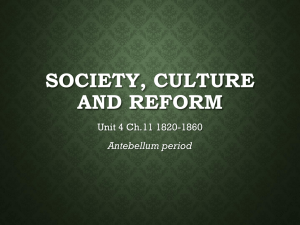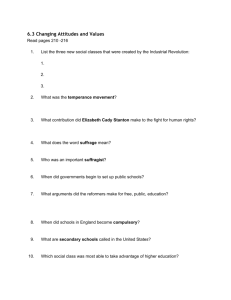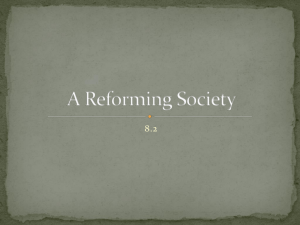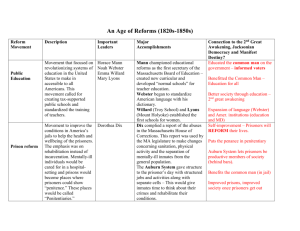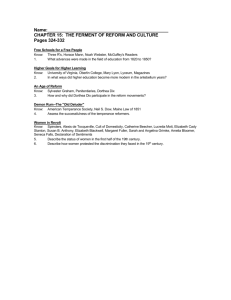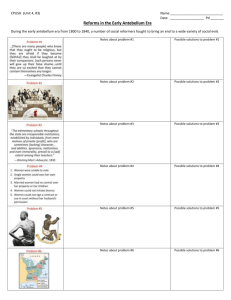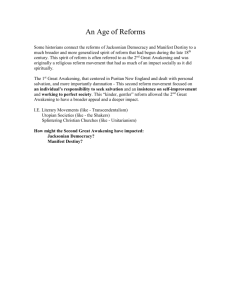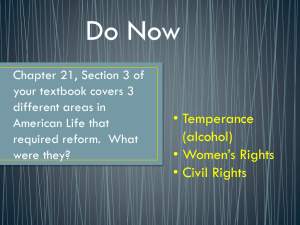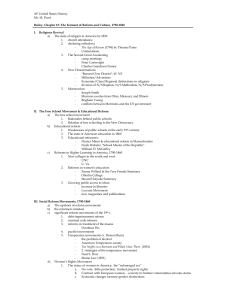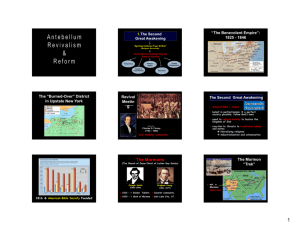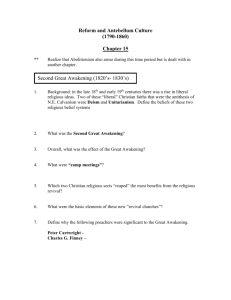Social Reforms of the 1800s
advertisement
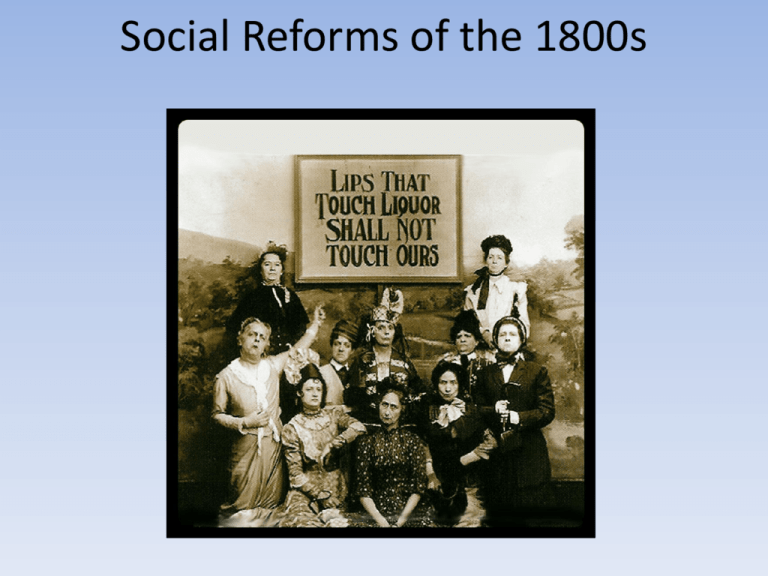
Social Reforms of the 1800s American Society • All of the changes to our nation during the Industrial Revolution obviously affected our society too • People were forced to adjust their lives to the changing economic and social realities • Just like the political leaders and business leaders of their time, the social leaders left society both divided and united behind their various agendas Second Great Awakening -One of the starting points for all these social reforms came in the form of a religious revival called the Second Great Awakening -One of the earliest events that sparked this was the Cane Ridge Revival in Kentucky -This was where around 10-15,000 people or so gathered in the countryside meeting for a few days praying, singing, and in some cases, dancing -It was important because it marked the beginning of a more charismatic version of Christianity -It also showed that this revival would be more about refining one’s personality rather than simply just more people going to church Spread of Revival • In addition to Cane Ridge, there were countless examples of revivals across the country, especially in one area of upstate New York • This was called the ‘Burned Over District’ because of the various revivals that swept over the area • Eventually, the movement coincided with westward migration What were they all about? • Revivalists, especially by the 1820s and 30s, saw a number of social ills that needed to be fixed • Some of these were slavery, alcoholism, women’s rights, prison conditions, and the social structure as a whole • They preached that these changes started with the individual, and once that individual was ‘saved’ they could impact the rest of society • How did this compare to the ‘First Great Awakening’? • It was more evangelical in nature and stressed one’s ability to overcome their problems as opposed to stressing God’s wrath • Soon, millions of Americans were caught up in the effort to address these issues Temperance • Perhaps the most important of the reforms that occurred was temperance • The average American in the 1820s drank more than 7 gallons of pure alcohol a year (more than 70 gallons of beer) • Temperance referred to ‘tempering’ the amount of alcohol that one consumed, not complete elimination • Others saw it as complete prohibition- how is that different? • One unique aspect of this reform was that women got heavily involved in it – why do you think that was the case? • Factory owners also got involved because they knew their workers would be productive if they were not drunk Stories • There was a good deal of differences between the different groups • The Washingtonians (over 600,000 members) focused on the individual alcoholic to recover • The American Temperance Society and Anti-Saloon League wanted to forbid the sale of alcohol • Churches, especially Protestant denominations, substituted wine with grape juice during Communion • Soon, some states outlawed the sale of alcohol- Maine being an early example The Drunkard’s Progress Women’s Rights • Up until the 1800s, women’s roles were mostly found in the household doing chores and raising families • By and large women could not vote, hold public office, own property, get a divorce, charge spousal abuse, or even speak in public situations • Education was also hard to come by because most colleges and universities only admitted men Changes • Early feminists such as Margaret Fuller began advocating that women have access to greater educational opportunities • The idea of educating women was seen as turning society upside down • Women also began questioning men’s superiority over their lives • In 1837, Oberlin College in Ohio was the first college to admit womenfour of them • Mount Holyoke College in Massachusetts was the one of the first college that was exclusively for females in the US • However, this was a rare occurrence and even after the Civil War there were few colleges that were coeducational Seneca Falls • In the summer of 1848, two women, Elizabeth Cady Stanton and Lucretia Mott, organized the first convention dedicated to promoting women’s rights • A few hundred people attended, and Stanton’s husband chaired the convention • Stanton composed the Declaration of Sentiments which famously said ‘all men and women are created equal’ • One hundred people, including Frederick Douglass, signed the document • Although it was small, soon other conventions started popping up across the Northeast Women Get Involved • • • • • • • Mott, Stanton, and Susan B. Anthony began including themselves in other reform movements such as abolitionism, temperance, and education reform Why would women be closely associated with temperance and abolitionism? However, the one idea that they pushed for the most was suffrage- which means what? In their eyes, especially after the passing of the 14th amendment, this was the one thing that they desperately wantedwhy? Several women, including Susan B. Anthony, would be arrested for voting in elections In 1869, Wyoming was the first state to allow women to vote and a year later allow women to serve on juries The right to vote wasn’t granted until the 19th Amendment in 1920 Utopianism • Some religious leaders sought to reform society by forming independent communities that would result in a perfect society • Some of these communes or phalanxes sought to completely isolate their members from outside influences • Some groups, such as the Shakers, sought to get a closer connection to God and had strict rules regarding relationships between men and women • Others like Brook Farm in Massachusetts, gave out equal pay to men and women and encouraged people to do the work together to better the community • Most of these died out after a few decades because of either divisions within the communities or their strict rules regarding procreation Oneida • One community that stood out was Oneida, in western New York • It was founded on the principle of bringing ‘heaven on earth’or creating a perfect society • This included ideas such as complex marriage and mutual criticism • Mutual criticism involved being brought before a committee or the entire community for doing something wrong • Complex marriage was the idea that no one was exclusively married to one person or another Health Reforms • Yet another issue that reformers sought to fix was the rather primitive medical treatments and knowledge that existed during the period • Medicine had not progressed much for centuries • Soon, universities began formal training for doctors and studying disease • Still, the idea of micro-organisms was not present and some interesting ideas came about such as blood letting, leeches, and hydrotherapy Diets • One other thing that health reformers noticed was the terrible diet that most people had • Advocates such as Sylvester Graham and John Harvey Kellogg all advocated that one’s health was connected to one’s diet • They advocated a diet of grains, fruits, and vegetables (vegetarianism)- no meat • Graham was credited with inventing the Graham cracker • Kellogg and his brother founded the Kellogg brand of cereal and invented Corn Flakes • • • • • Mental Health One other issue that reformers saw as a problem was the treatment of the mentally ill It was not uncommon for the mentally ill to be placed in prisons alongside violent criminals Soon, people like Dorothea Dix pushed for the creation of state run asylums that were dedicated to helping the mentally ill Most of these state hospitals, although good in their intentions, probably didn’t adequately serve their needs either At the same time, it was an important step in recognizing that mental illness was indeed an illness and not something criminal or religious in nature Prison Reforms • Before reforms, prisoners were not separated based on the crimes they committed • However, soon people realized that ex-convicts had a very difficult time adjusting to society upon release • So new prison ‘systems’ were put in place that both sought to rehabilitate and encourage remorse on the part of the prisoners Prisons, cont’d • Two of these new models for prisons were the Pennsylvania System and the Auburn System • The Pennsylvania System taught that discipline and hard work would reform the prisoners • The Auburn System believed in silence, work groups, and ‘lock step’ where prisoners were chained together and marched in step • How does this reflect on the reform culture that permeated the US?
